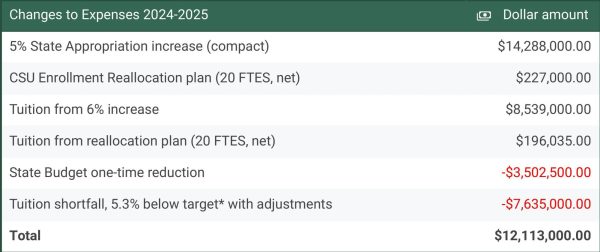This article was first published in the September 11 print edition of the University Times.
For Cal State LA, the current operating budget sits at $370 million. Due to the deficit, the college is operating $32.4 million shy of the usual amount. The school receives funds from several avenues, including funding provided by the state and money garnered from tuition. The disparity in revenue is caused by a significant decrease in collected tuition, compounded by the constraints of economic inflation and a decline in full-time students.

The revisions were proposed in May as a newfound effort to stabilize the state’s economy over the next several years. Due to the revisions, the CSUs face a $506 million cut within the next two years — the effects of which are already evident as the fall semester kicks off. Students can expect to see a significant decrease in the number of programs, reduced staffing, and larger class sizes as faculty attempt to mitigate the fiscal loss.
The Administration and Finance department sent a school-wide email on Sept. 5 that informed students of the recent change in available programs, stating there are “6.9 percent fewer sections compared to last year.”
In addition, the state will be able to reduce funding even further if the CSUs fail to meet certain criteria — particularly a 3% increase in full-time student enrollment.
While this enrollment growth target is meant to alleviate the fiscal strain, it places immense pressure on campuses, which are still recovering from the pandemic-induced enrollment decline. The optimistic goal of a 3% increase would only alleviate about half of the losses caused by the pandemic, leaving the CSU system still short of pre-COVID enrollment levels.
Despite fewer available classes and waitlisted students, the Cal State LA website affirms more reassuring numbers, stating, “Cal State LA offers some 4,000 course sections in any given semester. Our waitlists this semester average less than one student per section. This is not unusual. In fact, our waitlist numbers this fall semester are lower than in the past.”
This creates a precarious situation. Many campuses are already seeing significant drops in enrollment, and to reverse that trend, they would need to attract thousands of new students within a single year. Not only is this goal ambitious, but it also requires significant investment in outreach, student services and campus facilities — all of which are constrained by the very budget cuts they are trying to avoid.
For East Los Angeles Community College student Bella Holland, transferring to a university is a daunting endeavor.
“I’m a biology major, and eventually I do want to go to a university really soon,” Holland said. “It’s already hard to get into classes at ELAC, and knowing that every school I’m applying to is in debt, and everything is so expensive, I’m kind of worried.”
However, the state has promised some relief by offering two back payments totaling $517 million by 2027. These payments are meant to help with the financial limitations pushed on colleges, by providing support after the delay in funding. While this may offer temporary relief, it is unclear whether these payments will be enough to counterbalance the broader budget crises that the campuses and the state are facing.
Despite challenges, Cal State LA will continue to provide resources for new and continuing students. The Financial Aid Office is open weekdays from 10 a.m. to 5:30 p.m., and can be reached at (323) 343-6260.
Students can also seek out advice from a counselor on campus. Students can reserve an appointment slot through their GET account, or reach the department at advising@calstatela.edu for further information.















Mark Robinson • Jan 27, 2025 at 2:50 pm
Fewer classes and larger class sizes make it harder for students to graduate on time. This situation is frustrating and unfair to those paying tuition for a quality education.